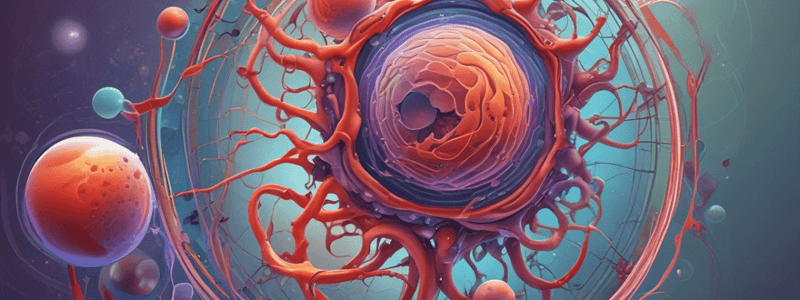Podcast
Questions and Answers
Where do B cells come from in the human body?
Where do B cells come from in the human body?
- Lymph nodes
- Bone marrow (correct)
- Spleen
- Thymus
What is unique about the daughter cells of B cells in the bone marrow?
What is unique about the daughter cells of B cells in the bone marrow?
- Each daughter cell has a different receptor (correct)
- They are identical to their parent cells
- They die immediately after formation
- They have the same receptor as their parent cells
What is the function of the receptor on B cells?
What is the function of the receptor on B cells?
- To divide rapidly
- To identify specific pathogens (correct)
- To mature into T cells
- To eliminate all bacteria
What is the thymus responsible for in the human body?
What is the thymus responsible for in the human body?
Why is the receptor on each B cell unique?
Why is the receptor on each B cell unique?
What is the result of the unique receptor on each B cell?
What is the result of the unique receptor on each B cell?
What is the location of the thymus in the human body?
What is the location of the thymus in the human body?
What is similar between the development of B cells and T cells?
What is similar between the development of B cells and T cells?
What happens to the selected B and T cells after they are alerted to the infection?
What happens to the selected B and T cells after they are alerted to the infection?
What is the main purpose of memory cells?
What is the main purpose of memory cells?
What happens to the receptors of the descendants of the selected B and T cells?
What happens to the receptors of the descendants of the selected B and T cells?
What is the name of the theory that describes this process of selecting and replicating B and T cells?
What is the name of the theory that describes this process of selecting and replicating B and T cells?
Where do the B and T cells meet the bacteria that are infecting the skin?
Where do the B and T cells meet the bacteria that are infecting the skin?
What do the B cells do to attack the bacterium?
What do the B cells do to attack the bacterium?
What is unique to each T cell?
What is unique to each T cell?
Where do B cells and T cells migrate to after they are ready?
Where do B cells and T cells migrate to after they are ready?
What is the result of the clonal selection process?
What is the result of the clonal selection process?
Why do we create memory cells?
Why do we create memory cells?
What is the primary function of dendritic cells?
What is the primary function of dendritic cells?
Why do T cells need antigen-presenting cells to recognize pathogens?
Why do T cells need antigen-presenting cells to recognize pathogens?
What is the purpose of the receptors on B cells and T cells?
What is the purpose of the receptors on B cells and T cells?
Where do B cells and T cells recognize and react to pathogens?
Where do B cells and T cells recognize and react to pathogens?
What is the result of the interaction between an antigen-presenting cell and a T cell?
What is the result of the interaction between an antigen-presenting cell and a T cell?
Why are B cells and T cells created randomly?
Why are B cells and T cells created randomly?
What is the role of MHC proteins on dendritic cells?
What is the role of MHC proteins on dendritic cells?
How do B cells recognize pathogens?
How do B cells recognize pathogens?
Flashcards are hidden until you start studying
Study Notes
Development of B and T Cells
- B cells originate from the bone marrow, where they undergo a unique process of development, resulting in genetically different daughter cells with unique receptors.
- Each B cell receptor is specific to a particular pathogen, making it useless against other pathogens.
- A similar process occurs in the thymus for T cells, where they develop unique receptors that identify specific pathogens.
Maturation and Migration
- Once developed, B and T cells migrate to lymph nodes, where they wait for their specific pathogen to appear.
- Lymph nodes are located throughout the body, with around 600 in total.
- B and T cells lie in wait, each with their unique receptors, ready to react to their specific pathogen.
Infection and Activation
- When a tissue becomes infected, dendritic cells ingest bacteria and present pieces of them to B and T cells in the lymph node.
- The specific B and T cells that recognize the pathogen are alerted and bind to the presented antigen.
- These cells then activate, replicating rapidly to produce an army of cells with the same receptor.
Clonal Selection
- The process of selecting and replicating specific B and T cells is called clonal selection.
- Activated B cells produce antibodies to attack the pathogen, while T cells travel to the site of infection to join the battle.
- Some activated cells become memory cells, waiting for the next time the pathogen appears, while others become effector cells, ready to fight the infection immediately.
Studying That Suits You
Use AI to generate personalized quizzes and flashcards to suit your learning preferences.




